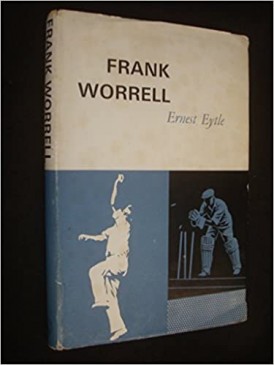Frank Worrell
Dave Wilson |Published: 1965
Pages: 196
Author: Eytle, Ernest
Publisher: The Sportsmans Book Club
Rating: 4 stars

According to our resident bibliophile Martin Chandler, there are at least three other biographies on Frank Worrell of which he is aware – one by Ivo Tennant, one by Undine Guiseppe, published in 1987 and 1969 respectively, and later a ‘pictorial biography’ by Torrey Pilgrim in 1992. However, as none of these have been reviewed on Cricketweb, I took the opportunity to review one of 150 cricket books that I recently received in consignment. This book was written in 1965, two years after Worrell retired, which was also just two years before his untimely death. A quick Google search reveals that his biographer, Ernest Eytle, hosted a Caribbean music show on BBC radio, which is entirely appropriate for the brother of noted calypso musician Tommy Eytle (more familiar to British TV viewers as EastEnders character Jules Tavernier). In addition, and as noted in the foreword written by the great Sir Learie Constantine, Ernest Eytle was a useful cricketer – in fact, “Connie” spends as much time introducing Eytle as he does extolling Worrell.
I must admit that I typically don’t become engaged with the opening chapters of biographies as they are often simply lists of chronological facts. However in this book Worrell adds his own comments at the end of each chapter and this certainly elevates the book to much more than the typical. For example, Worrell admits to suffering from a significant persecution complex in his youth. We also get a glimpse of the grace for which he was known on the cricket field, as he acknowledges almost no credit for his own performances. One of only two batsmen to ever feature in not one but two partnerships of over 500 runs (the other being Ravindra Jadeja), he plays down the first as it was made on the easy batting surfaces in Barbados, though he does admit to some pride in the second, being made on a matting wicket in Trinidad against a pace attack of Lance Pierre and Prior Jones, an opening pair that eclipsed even Lindwall and Miller in Worrell’s opinion.
It was during the various island treks that Worrell was to decide that late night card schools were detrimental to quality cricket and he would go on to ban them on assuming captaincy responsibilities. Worrell impressed early and, after a successful Test debut against Gubby Allen’s touring MCC side, he was recruited by Radcliffe to play in the Central Lancashire league. Worrell notes that he learned more in three years of league cricket than he would have in twelve years of international cricket, and this would prove useful a couple of years later when the West Indies toured England, notably with a mammoth 261 at Trent Bridge (though again he downplayed this performance due to the wicket). While with Radcliffe and with an eye to the future he enrolled at Manchester University and studied Economics.
Eytle voices the opinion that Worrell was less successful at home, though this is really true only of his bowling, while he also mentions on a number of occasions of Worrell’s propensity to miss Tests – during the period between Worrell’s debut and his final Test in 1963, West Indies played 77 Tests of which Worrell appeared in 51, so he may have a point there. When the West Indies returned to England in 1957, again under John Goddard though much less successfully than in 1950, Worrell was asked to open both the bowling and the batting, probably reducing his effectiveness in both.
Worrell’s finest hour though was the tour of Australia in 1960-61 when, following a campaign by CLR James, he was named captain of the national side. Worrell’s stated aim from the off was to play bright cricket (a sentiment that was fortunately echoed by Aussie skipper Richie Benaud) and, after some early teething troubles during warm-up and state matches, this was carried out to a phenomenal degree, beginning with the euphoria of the first Tied Test, and culminating in a ticker tape ride though Melbourne that was astonishing for a losing captain and team.
The book itself is an easy read at 196 pages, and interestingly the cover photos are of a batsman and wicketkeeper, rather than of Worrell himself, though this may have been typical of the Sportsman’s Book Club series – my dad has a few of those, though none of the dust jackets have survived. I do have one or two minor niggles – Eytle’s style, while usually on point, sometimes veers off into flowery innocence, and the book may also have benefited from some closer proof-reading, for example the subject’s name is given as Frank Maglinne Worrell, omitting Mortimer.
But these are very minor niggles and the book fully deserves its four star rating.






Leave a comment